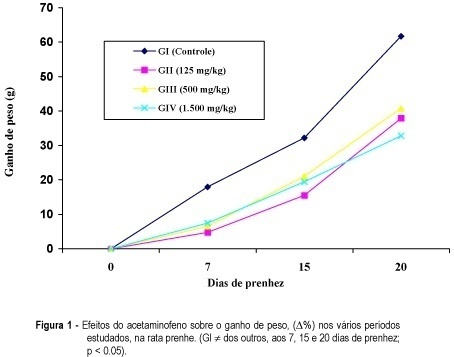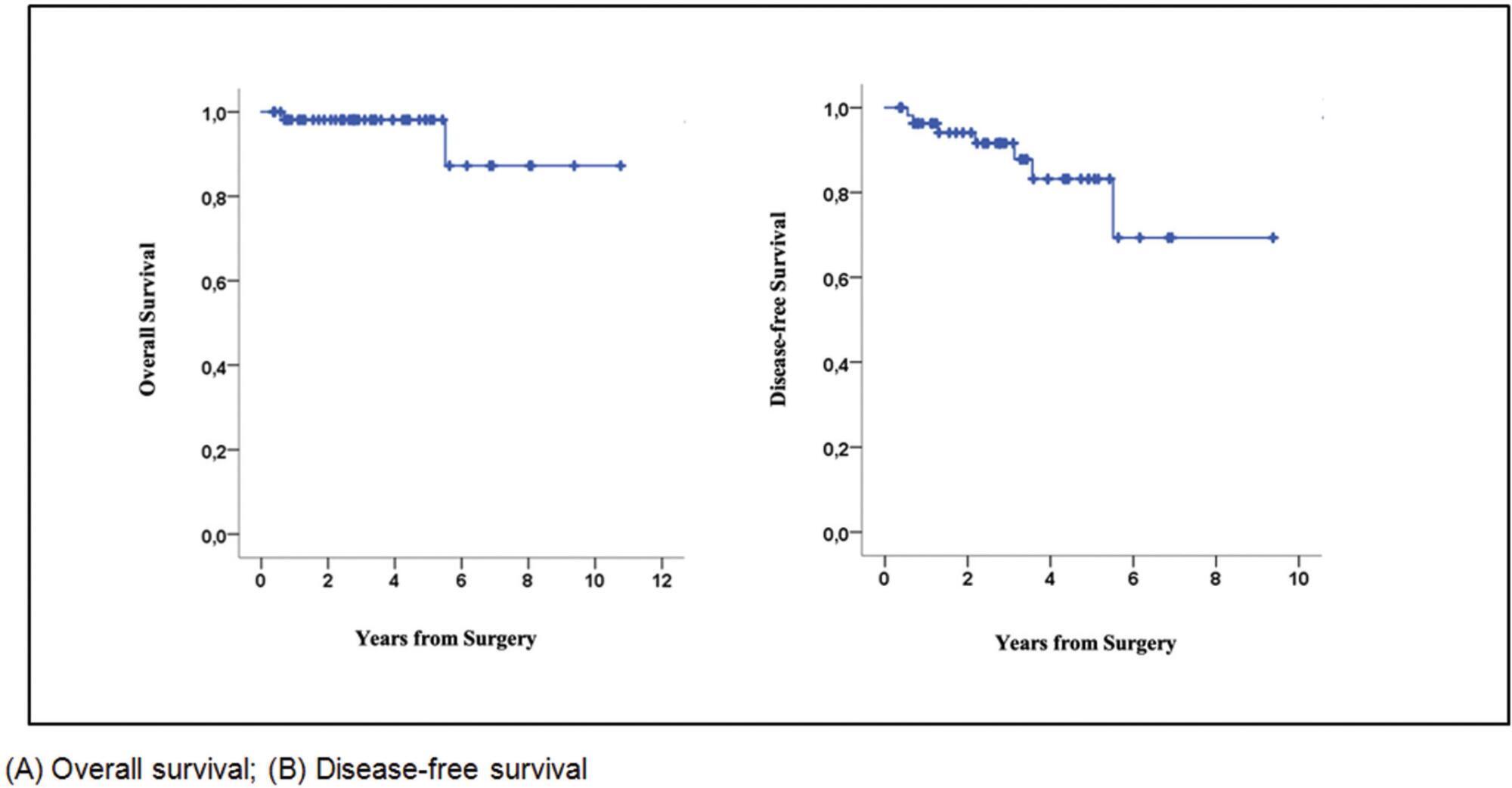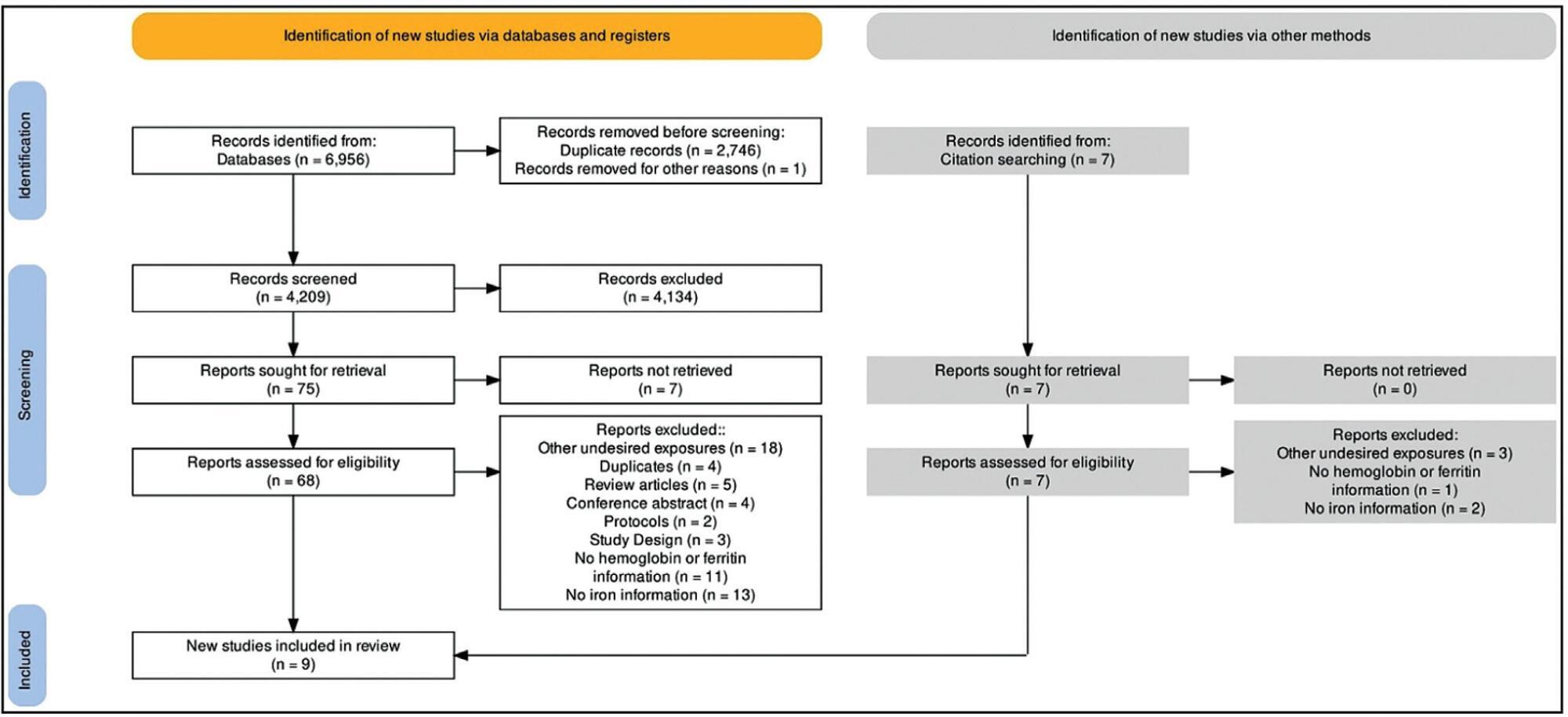Summary
Revista Brasileira de Ginecologia e Obstetrícia. 1999;21(2):105-108
DOI 10.1590/S0100-72031999000200008
Purpose: to evaluate the effects of acetaminophen on the pregnancy of female albino rats. Methods: forty pregnant rats were separated into four groups. All the animals received daily by gavage 1 ml of acetaminophen solution from the first day (day zero) until the 20th day of pregnancy: group I - only distilled water (control); groups II, III and IV, respectively, 125, 500 and 1,500 mg/kg body weight of acetaminophen dissolved in distilled water. The animals were weighed on days 0, 7, 15 and 20 of pregnancy. Results: our results showed that the rats that received the medication presented a reduction in weight when compared to the control group. The incidence of reabsorption of the embryos was 2.0, 3.5 and 7.0 times higher than in the control, in groups II, III and IV, respectively. Groups GII and GIV showed a clear reduction in the weight of the concepts. In GIV there was a 50% reduction in weight increase of fetuses and placentas when compared to the control, and 15.7% of external malformations were also found. Conclusions: the continuous use of acetaminophen should be avoided at doses higher than 70 mg/kg per during pregnancy.

Summary
Revista Brasileira de Ginecologia e Obstetrícia. 2004;26(2):105-110
DOI 10.1590/S0100-72032004000200004
PURPOSE: to evaluate the high-risk oncogenic human papillomavirus (HPV) detection rate of patients with cervical intraepithelial neoplasia (CIN), checking the association between high-risk HPV, viral load and severity of the lesion, as well as the best viral load cutoff to predict lesion severity. METHODS: this is a cross-sectional study. One hundred and ten patients were selected by cytology and/or biopsy with CIN diagnosis. All of them were submitted to a new oncologic cytology, hybrid capture II (HC II), colposcopy, and loop electrosurgical excision and fulguration procedures (LEEP). RESULTS: the global detection rate of high-risk oncogenic HPV in these women was 77.3%. Eighty-one women (73.7%) had CIN with a detection rate of HPV-DNA of 87.6%. In women with CIN 2 or 3 the detection rate was 85.9%. HC II had a sensitivity of 87.8%, specificity of 56.0%, predictive positive value of 86.6% and predictive negative value of 58.3%, with an odds ratio of 7.76 (2.47 < OR < 25.15) for CIN 2 or 3 diagnosis. Using a receiver operator characteristic curve a viral load cutoff was set at 20 pg/mL in this population, with a predictive positive value of 81.3%. CONCLUSIONS: HPV DNA detection rate of patients with CIN was 77.3%. In women with CIN 2/3 it was 85.9%. The best viral load cutoff to predict cervical lesion severity was 20 pg/ml. Above this level the probability of high-risk oncogenic HPV detection is greater than 80%.
Summary
Revista Brasileira de Ginecologia e Obstetrícia. 2022;44(11):1052-1058
Nipple-sparing mastectomy (NSM) has been traditionally used in selected cases with tumor-to-nipple distance > 2 cm and negative frozen section of the base of the nipple. Recommending NSM in unselected populations remains controversial. The present study evaluated the oncological outcomes of patients submitted to NSM in an unselected population seen at a single center.
This retrospective cohort study included unselected patients with invasive carcinoma or ductal carcinoma in situ (DCIS) who underwent NSM in 2010 to 2020. The endpoints were locoregional recurrence, disease-free survival (DFS), and overall survival (OS), irrespective of tumor size or tumor-to-nipple distance.
Seventy-six patients (mean age 46.1 years) (58 invasive carcinomas/18 DCIS) were included. The most invasive carcinomas were hormone-positive (60%) (HER2 overexpression: 24%; triple-negative: 16%), while 39% of DCIS were high-grade. Invasive carcinomas were T2 in 66% of cases, with axillary metastases in 38%. Surgical margins were all negative. All patients with invasive carcinoma received systemic treatment and 38% underwent radiotherapy. After a mean of 34.8 months, 3 patients with invasive carcinoma (5.1%) and 1 with DCIS (5.5%) had local recurrence. Two patients had distant metastasis and died during follow-up. The 5-year OS and DFS rates for invasive carcinoma were 98% and 83%, respectively.
In unselected cases, the 5-year oncological outcomes following NSM were found to be acceptable and comparable to previous reports. Further studies are required.

Summary
Revista Brasileira de Ginecologia e Obstetrícia. 2022;44(11):1059-1069
The aim of this study was to systematically review literature on the use of iron supplements (not including iron derived from diet), increased levels of hemoglobin and/or ferritin, and the risk of developing gestational diabetes mellitus (GDM).
The following databases were searched, from the study's inception to April 2021: PUBMED, Cochrane, Web of Science, Scopus, Embase, Cinahl and Lilacs.
A total of 6,956 titles and abstracts were reviewed, 9 of which met the final inclusion criteria, with 7,560 women in total.
Data extraction was performed by two independent reviewers and disagreements were resolved by a third researcher.
Methodological quality in controlled trials were assessed according to the Cochrane Collaboration tools (ROB-2 and ROBINS-1) and for the observational studies, the National Institutes of Health's (NIH) quality assessment tool was used. Among the 5 observational studies, women with a higher hemoglobin or ferritin level were more likely to develop GDM when compared with those with lower levels of these parameters. Among the 3 randomized clinical trials, none found a significant difference in the incidence of GDM among women in the intervention and control groups. However, we identified many risks of bias and great methodological differences among them.
Based on the studies included in this review, and due to the important methodological problems pointed out, more studies of good methodological quality are needed to better establish the association between iron supplementation and GDM.

Summary
Revista Brasileira de Ginecologia e Obstetrícia. 2018;40(3):106-114
The aim of this study is to evaluate the burden of indirect causes of maternal morbidity/mortality in Brazil.
Secondary analysis of a multicenter cross-sectional study conducted in 27 referral obstetric units within the Brazilian Network for Surveillance of Severe Maternal Morbidity.
A total of 82,388 women were surveilled: 9,555 women with severe maternal morbidity were included, and 942 (9.9%) of them had indirect causes of morbidity/ mortality. There was an increased risk of higher severity among the indirect causes group, which presented 7.56 times increased risk of maternal death (prevalence ratio [PR]: 7.56; 95% confidence interval [95%CI]: 4.99-11.45). The main indirect causes of maternal death were H1N1 influenza, sepsis, cancer and cardiovascular disease. Non-public antenatal care (PR: 2.52; 95%CI: 1.70-3.74), diabetes (PR: 1.90; 95%CI: 1.24-2.90), neoplasia (PR: 1.98; 95%CI: 1.25-3.14), kidney diseases (PR: 1.99; 95%CI: 1.14-3.49), sickle cell anemia (PR: 2.50; 95%CI: 1.16-5.41) and drug addiction (PR: 1.98; 95%CI: 1.03-3.80) were independentlyassociatedwithworseresultsintheindirectcausesgroup.Someprocedures for the management of severity were more common for the indirect causes group.
Indirect causes were present in less than 10% of the overall cases, but they represented over 40% of maternal deaths in the current study. Indirect causes of maternal morbidity/mortality were also responsible for an increased risk of higher severity, and they were associated with worse maternal and perinatal outcomes. In middle-income countries there is a mix of indirect causes of maternal morbidity/ mortality that points to some advances in the scale of obstetric transition, but also reveals the fragility of health systems.
Summary
Revista Brasileira de Ginecologia e Obstetrícia. 2020;42(2):106-113
Genital injury has a forensic relevance after a sexual assault and it has been discussed and investigated among professionals who work in this field. To analyze the studies published in the last decades, the present review examines different factors that may influence this finding, first clarifying terms of the forensic field, such as the peculiarity of the legal medical examination, and the distinction of the terms “legal” and “anatomical” vagina. Finally, it analyses if it is possible that the existence of these injuries in victims explain the lack of consent in sexual contact, and to clarify the meaning of the absence of injuries.
Summary
Revista Brasileira de Ginecologia e Obstetrícia. 2021;43(2):107-112
To evaluate the obstetric and sociodemographic characteristics of gestational diabetic women who maintained hyperglycemia in the postpartum period (6-12 weeks postpartum).
This is a longitudinal cohort study with women who have had gestational diabetes and/or macrosomic children between March 1st, 2016 and March 1st, 2017. Between 6 and 12 weeks after birth, women who had gestational diabetes collected fasting glycemia, glucose tolerance test, and glycated hemoglobin results. The data were collected from medical records and during an interview in the first postpartum consultation. A statistical analysis was performed using frequency, percentage, Chi- Squared test, Fisher exact test, Mann-Whitney test, and multivariate Poisson regression. The significance level adopted for the statistical tests was 5%.
One hundred and twenty-two women were included. Most of the women were younger than 35 years old (70.5%), white, multiparous, and with no history of gestational diabetes. Thirteen percent of the participants developed persistent hyperglycemia. A univariate analysis showed that maternal age above 35 years, being overweight, having grade 1 obesity and weight gain under 5 kg was related to the persistence of hyperglycemia in the postpartum period.
Maternal age above 35 years, obesity and overweight, and the diagnosis of gestational diabetes in the first trimester of pregnancy are associated with hyperglycemia during the postpartum period.